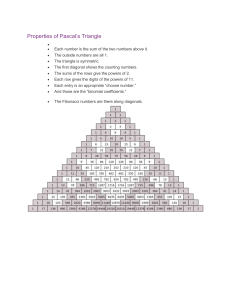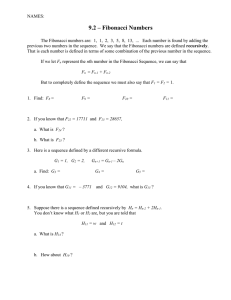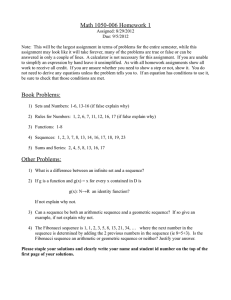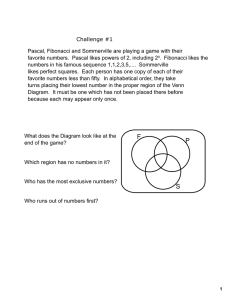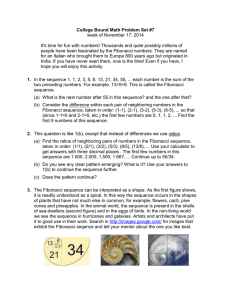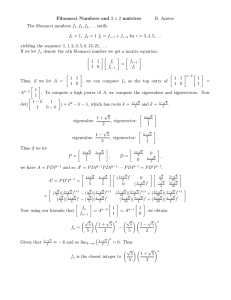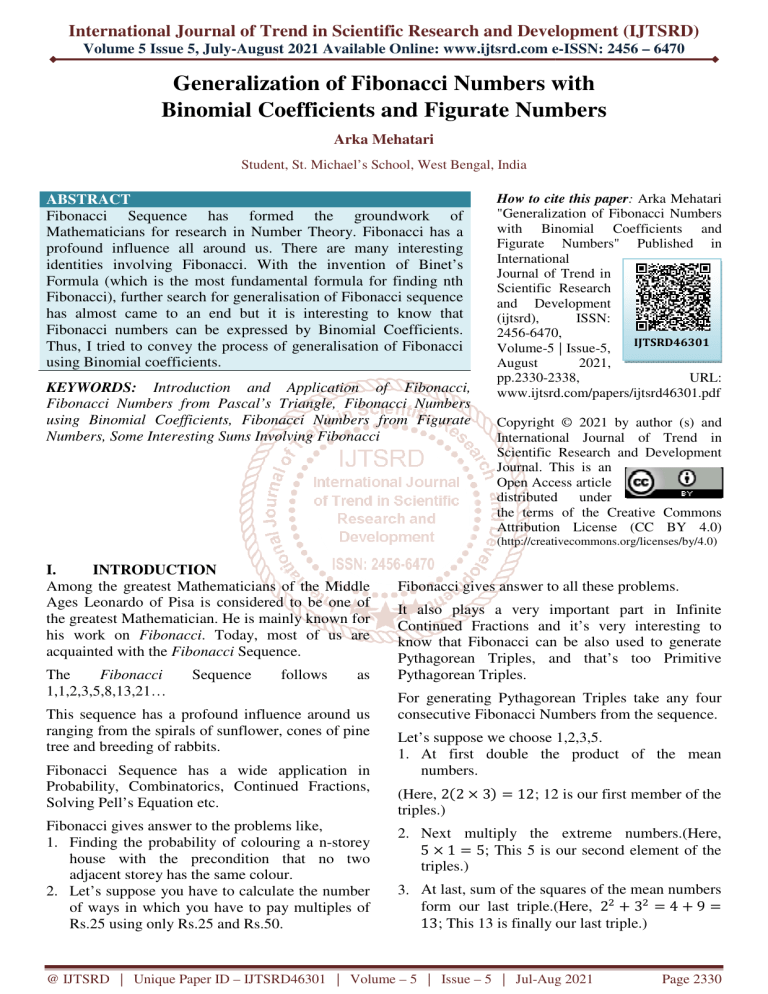
International Journal of Trend in Scientific Research and Development (IJTSRD)
Volume 5 Issue 5, July-August
August 2021 Available Online: www.ijtsrd.com e-ISSN:
e
2456 – 6470
Generalization of Fibonacci Numbers with
Binomial Coefficients and
nd Figurate Numbers
Arka Mehatari
Student, St. Michael’s
Micha
School, West Bengal, India
How to cite this paper: Arka Mehatari
"Generalization of Fibonacci Numbers
with Binomial Coefficients and
Figurate Numbers" Published in
International
Journal of Trend in
Scientific Research
and Development
(ijtsrd),
ISSN:
2456-6470,
6470,
IJTSRD46301
Volume-55 | Issue-5,
Issue
August
2021,
pp.2330-2338,
2338,
URL:
www.ijtsrd.com/papers/ijtsrd46301.pdf
ABSTRACT
Fibonacci Sequence has formed the groundwork of
Mathematicians for research in Number Theory. Fibonacci has a
profound influence all around us. There are many interesting
identities involving Fibonacci. With the invention of Binet’s
Formula (which is the most fundamental formula for finding nth
Fibonacci), further search for generalisation of Fibonacci
Fibon
sequence
has almost came to an end but it is interesting to know that
Fibonacci numbers can be expressed by Binomial Coefficients.
Thus, I tried to convey the process of generalisation of Fibonacci
using Binomial coefficients.
KEYWORDS: Introduction and Application of Fibonacci,
Fibonacci Numbers from Pascal’s Triangle, Fibonacci Numbers
using Binomial Coefficients, Fibonacci Numbers from Figurate
Numbers, Some Interesting Sums Involving Fibonacci
Copyright © 2021 by author (s) and
International Journal of Trend in
Scientific Research and Development
Journal. This is an
Open Access article
distributed
under
the terms of the Creative Commons
Attribution License (CC BY 4.0)
(http://creativecommons.org/licenses/by/4.0)
I.
INTRODUCTION
Among the greatest Mathematicians of the Middle
Ages Leonardo of Pisa is considered to be one of
the greatest Mathematician. He is mainly known for
his work on Fibonacci.. Today, most of us are
acquainted with the Fibonacci Sequence.
The
Fibonacci
1,1,2,3,5,8,13,21…
Sequence
follows
as
This sequence has a profound influence around us
ranging from the spirals of sunflower, cones of pine
tree and breeding of rabbits.
Fibonacci Sequence has a wide application in
Probability, Combinatorics, Continued Fractions,
Solving Pell’s Equation etc.
Fibonacci gives answer to the problems like,
1. Finding the probability of colouring a n-storey
n
house with the precondition that no two
adjacent storey has the same colour.
2. Let’s suppose you have to calculate the number
of ways inn which you have to pay multiples of
Rs.25 using only Rs.25 and Rs.50.
Fibonacci gives answer to all these problems.
It also plays a very important part in Infinite
Continued Fractions and it’s very interesting to
know that Fibonacci can be also used to generate
Pythagorean Triples, and that’s too Primitive
Pythagorean Triples.
For generating Pythagorean Triples take any four
consecutive Fibonacci Numbers from the sequence.
Let’s suppose we choose 1,2,3,5.
1. At first double the product of the mean
numbers.
(Here, 2 2
triples.)
3
12;; 12 is our first member of the
2. Next multiply the extreme numbers.(Here,
5 1 5;; This 5 is our second element of the
triples.)
3. At last, sum of the squares of the mean numbers
form our last triple.(Here, 2
3
4 9
13; This 13 is finally
lly our last triple.)
@ IJTSRD | Unique Paper ID – IJTSRD46301
IJTSRD
| Volume – 5 | Issue – 5 | Jul-Aug
Aug 2021
Page 2330
International Journal of Trend in Scientific Research and Development @ www.ijtsrd.com eISSN: 2456-6470
Finally, our Pythagorean Triple is (12,5,13)
We can check our answer;
12
5
144 25 169 13
Let’s check how it forms.
This can be generalised as following;
Fn denotes the nth Fibonacci element. Our four
Fibonacci Elements will be Fn, Fn+1, Fn+2, Fn+3.
(a,b,c) forms our ordered Pythagorean Triples.
a, b, c
2F
F
2F
,F
F
,F
The general term for Fibonacci can be concluded
as,
(i.e., each term is formed by
summing previous terms).
II.
PASCAL’S TRIANGLE
Pascal Triangle was discovered by French
Mathematician Blaise Pascal. The Pascal’s Triangle
is a triangle formed by the coefficients of the
binomial expansion.
The triangle looks as follows.
All the terms at the ends are 1 and thus following
the Coefficients of Binomial Expansions, the first
and the last terms are given a as
and
0
respectively where n denotes the row numbers. The
middle elements are formed by following the
t
pascal’s rule.
III.
FIBONACCI
NUMBERS
FROM
PASCAL’S TRIANGLE
It is interesting to know that Fibonacci Numbers
can also be derived from the pascal’s triangle. This
was first observed by British Mathematician Ron
Knott. Later this was studied by French
Mathematician
tician Francois Edouard Anatole Lucas.
The diagonals of a Pascal’s Triangle add up to the
nth Fibonacci Number. Let’s check how it comes.
The diagonals of a Pascal Triangle can be added up
in this way to get the Fibonacci Numbers.
Consider that 0 is placed at the sides of the pascal’s
triangle. The first rule is that the numbers at the two
ends will be formed by summing the top two terms.
All the numbers at the end are 1.The middle
elements of Pascal’s Triangle is actually formed by
the binomial coefficients following the Pascal’s
Rule.
The first element of Pascal’s Triangle is 1
0
represented by Binomial Coefficient as
.
0
0
So, the first element is
.
0
The next terms of the Pascal’s Triangle are formed
by summing the top binomial coefficients.
1
1
0
1
Summing up the diagonals
diagona in this way can give us
the Fibonacci Numbers from Pascal’s Triangle.
IV.
REPRESENTATION OF FIBONACCI
NUMBERS
USING
BINOMIAL
COEFFICIENTS.
Fibonacci Numbers can be derived from summing
the diagonals of Pascal’s Triangle which in turn is
actually formed by Binomial
inomial Coefficients.
@ IJTSRD | Unique Paper ID – IJTSRD46301
IJTSRD
| Volume – 5 | Issue – 5 | Jul-Aug
Aug 2021
Page 2331
International Journal of Trend in Scientific Research and Development @ www.ijtsrd.com eISSN: 2456-6470
This paves our path that in some way Fibonacci
Numbers can be generalised using Binomial
Coefficients.
By the formation of Pascal Triangle using Binomial
Coefficients, let relate the Fibonacci Numbers in
similar way.
The Fibonacci terms can be represented using the
Binomial Coefficients in the following way.
Let F(n) denote the Fibonacci Number at nth term.
1
2
1
1
0
0
1
0
2
0
3
0
4
0
5
0
1
1
2
4
3
1
3
2
5
5
1
2
4
3
6
8
1
2
6
4
3
5
7
13
0
3
2
1
7
4
6
5
8
21
0
3
1
2
The sequence continues in this way.
3
2
V.
GENERALISATION OF FIBONACCI
NUMBERS
USING
BINOMIAL
COEFFICIENTS
For a Fibonacci Number
, the representation
using summation of Binomial Coefficients follows
a specific pattern. This pattern can be generalised
as,
−1
0
−4
−2
−3
3
1
2
−6
−5
⋯
5
4
By a slight observation of the above pattern one
can deduce that the sum of the upper and lower
terms of the Binomial Coefficients is always −
1 for the Fibonacci Number.
Now, we have to generalise this sum in a closed
form.
We have to derive a formula for finding the nth
term of Fibonacci( ). According to the division
algorithm,every n ∈ ℕ is either of the form 2'
or 2' 1. [As when divisible by 2]
Considering the case of 2' 1. Adding and
subtracting 1 to it we get 2' 1.
ALGORITHM - I
For any Fibonacci Number
( ⊂ ℕ)where
(
and
∈ ((clear that
*2' − 1 | ' ∈ ℤ; 2' − 1 > 0/
The lower term of the coefficients run from
0to
.So as to meet our precondition
that the sum of upper term and the lower term of
the binomial coefficients must be − 1, the upper
term must be assigned a value of
− 1 − to
make the sum of the upper and lower terms as
− 1.
Therefore, for any Fibonacci Number and
(where ( *2' − 1 | ' ∈ ℤ; 2' − 1 > 0/.
∈
The
is defined as the sum of coefficients whose
upper term is − 1 − and the lower term runs
from
0to
.
In a more generalised way this can be written as,
0
234
−
−1
∀
∈( ⋯ 1
ALGORITHM - II
Our next aim is to generalise the formula for
which ∉ (.
in
It is clear that the set P includes all the possibilities
of n which is of the form 2' − 1.
Next, we have to find a formula for n which is of
the form 2'.
For any Fibonacci Number
7 ⊂ ℕ) where
7
and
*2' | ' ∈ ℤ; 2' > 0/
∈ 7(clear that
The lower term of the coefficients run from
0
to
. So as to meet our precondition that the
sum of upper term and the lower term of the
binomial coefficients must be − 1, the upper term
must be assigned a value of
− 1 − to make
the sum of the upper and lower terms as − 1.
Therefore, for any Fibonacci Number and ∈
7where7 *2' | ' ∈ ℤ; 2' ≥ 0/.The
is
defined as the sum of coefficients whose upper term
is − 1 − and the lower term runs from
0to
.
In a more generalised way this can be written as,
@ IJTSRD | Unique Paper ID – IJTSRD46301 | Volume – 5 | Issue – 5 | Jul-Aug 2021
Page 2332
International Journal of Trend in Scientific Research and Development @ www.ijtsrd.com eISSN: 2456-6470
−
0
234
−1
∀
We have verified our base step.
∈7 ⋯ 2
INDUCTION HYPOTHESIS:
We have,
Through the equations (1) and (2), all the
possibilities of n are covered.
Our final conjecture is given as follows,
<
:0
:234
−
;
:
:0
9 234
−1
−
∀
−1
∀
?
∈(:
:
>
:
∈ 7:
=
Let this be considered as a Fi-binomial conjecture.
THEOREM – I :
−
0
234
−1
∀
@
234
∴@
@
−
0
234
−1
∀
*2' − 1 | ' ∈ ℤ; 2' − 1 > 0/
In, set P it is clear that the set elements differ by 2.
By the definition of Fibonacci we know;
@
1
BASE PROOF:
@ 1
@ 3
4
0
234
1−
1−0−1
0
2
0
0
234
1
1
3−
1
@
@
−1
0
0
1
234
1
∀
∈(
∀
∈(
234
0
234
0
@
−
0
23
−
23
−1
0
−
0
0B
234
−1
1
−1
−2
−
0
−0
0
We have our set P as,
(
234
∈(
Satisfying the condition,
@
1
@
@ −1
1
∈(
∀
−
0
1
The above theorem can easily be proved by
Mathematical Induction.
Let define it as a function.
−1
We need to show,
PROOF:
@
−1
∴@
∈(
−
0
−1
0
−
23
−1
−
−1
@
−1
−
−
−1
0
23
−
0
234
0
234
−1
C
−1
−
−2
−
−1
−1
−2
We have proved it by Mathematical Induction
satisfying the condition, @
1
@
@ −
1 .
THEOREM – II:
2
0
234
−
−1
∀
∈7
@ IJTSRD | Unique Paper ID – IJTSRD46301 | Volume – 5 | Issue – 5 | Jul-Aug 2021
Page 2333
International Journal of Trend in Scientific Research and Development @ www.ijtsrd.com eISSN: 2456-6470
PROOF:
The above theorem can easily be proved by
Mathematical Induction.
1
Let define it as a function,
@
0
234
−
−1
∀
0B
−1
0
∈7
0
We have our set Q as,
7 *2' | ' ∈ ℤ; 2' > 0/
In set Q, it is clear that the elements differ by 2.
234
By the definition of Fibonacci, we know;
@
1
@
@ −1
0
4
BASE PROOF:
@ 2
@ 4
1
0
0
234
1
0
234
2−
−1
4−
−1
234
@
∴@
234
−1
D
0
234
−1
−
1
0
234
1
−0
0
0
234
0
23
@
−1
−1
D
0
234
23
−
0
234
0
−
−
−2
−1
−1
−2
Considering a Fibonacci number which is of the
form 2' − 1.
It can be calculated by Index as,
∀
∈7
−2
∀
E
0
234
2' − 2 −
∀' ∈ℕ ⋯ 3
ALGORITHM – IV
Considering a Fibonacci number which is of the
form 2' − 1.
∈7
It can be calculated by Index as,
−
Satisfying the condition, @
1 .
∴@
−
−1
−1
Now, ' ∈ ℕ;
We need to show,
∴@
−
23
−
−1
C
−1
It is known every even and odd number is in the
form 2' and 2' − 1 respectively.
We have,
−
0
−
ALGORITHM - III
This Fi-binomial Conjecture can also be formulated
based on the index.
INDUCTION HYPOTHESIS:
0
−1
We have proved it by Mathematical Induction
satisfying the condition, @
1
@
@ −
1 .
3
2
1 2 3
0
1
We have verified our base step.
@
23
−
−
−
∀
∈7
1
E
@
@
−
0
234
2' − 1 −
∀' ∈ℕ ⋯ 4
Again, Mathematical Induction is enough to prove
these formulas.
Up till, now we generalised Fibonacci Number
using Binomial Coefficients using two different
Formulas.
These two formulae can be summarised into one.
We contend our conjecture,
@ IJTSRD | Unique Paper ID – IJTSRD46301 | Volume – 5 | Issue – 5 | Jul-Aug 2021
Page 2334
International Journal of Trend in Scientific Research and Development @ www.ijtsrd.com eISSN: 2456-6470
<
:0
:234
−
;
:
:0
9 234
−1
−
−1
Where P and Q are given as,
(
7
∀
∀
*2' − 1 | ' ∈ ℤ; 2' − 1 > 0/
?
∈(:
:
>
:
∈ 7:
=
*2' | ' ∈ ℤ; 2' > 0/
ALGORITHM - V
In both the cases the Summation term is same, only
the upper limit of the summation differs in the
cases.
When n is of the form 2' − 1, the upper limit of the
summation is − .
When n is of the form 2', the upper limit of the
summation is − 1.
Actually, for both the cases the upper limit of the
summation is the greatest integer function of
.
This can be represented by the floor function as,
F G.
Now, we can summarise both the formulas into one.
We have,
F
0
G
−
234
−1
∀
∈ℕ ⋯ 5
Using Eq. (5), we can find
term.
The above equation can easily be proved by
Mathematical Induction.
THEOREM – III:
0
G
−
234
−1
By the definition of Fibonacci, we know
1
@
@
@ 1
−1
1−
−1
2−
−1
0
234
0
1
0
For n=2;
4
@ 2
0
234
1
1
0
We have verified our base step.
INDUCTION HYPOTHESIS:
We have,
@
F
−1
F
@
0
G
0
G
−
234
−
234
−2
−1
We need to show;
@
F G
1
∴@
0
234
1
−0
0
−
F G
0
234
F G
0
23
−
−
Now , we have the upper limit as F G − 1.
For a value of x, H'I
1.
∴ 1 ' < 2 or ' ∈ [1,2 . Taking the mean value
of'we have'
.
F G
PROOF:
We can prove this by Mathematical Induction.
@
4
for any value of nth
Based on the requirements, one can use any of the
formulas for finding the Fibonacci Number.
F
BASE PROOF:
Taking n=1;
∴0
23
−
−0
0
F G
0
23
−
@ IJTSRD | Unique Paper ID – IJTSRD46301 | Volume – 5 | Issue – 5 | Jul-Aug 2021
Page 2335
International Journal of Trend in Scientific Research and Development @ www.ijtsrd.com eISSN: 2456-6470
F G F G
−0
0
F
1
F
1
F
1
0
23
23
G
0
G
G
N3
F
F
0
234
0
G
234
@
0
23
F
−2
0
G
n−k−1
k
−
−
G
F
0
23
@
F
n−k−1
k
−2
0
F
Natural Numbers (linear numbers)
represented by Binomial Coefficients as,
−
0 B
N3
−
0
That can also be used to represent Fibonacci using
Figurate Numbers.
G
G
−1
−
−
−
G F G
0
234
F
F
−2
−
0
234
0
G
−
−
@
1
Satisfying,@
VI.
0
234
1
−
@
@
0
2
1
23
1
∀
∈ℕ
Similarly, other 3-D figurate numbers such as
Tetrahedral(appear in the fourth diagonal of
Pascal’s Triangle) and Pentatope Numbers(known
as 4-simplex appear in the fifth diagonal of Pascal’s
Triangle) number are respectively of the form,
Q
00
Q3 23
1
U
Q
000
U3 Q3 23
3
2
∀
4
1
∈ℕ
3
∀
∈ℕ
Where Ten and Ptopn represents the nth Tetrahedral
and Pentatope Number respectively.
Similarly, for a r-simplex number which appear on
the (r+1)th diagonal of Pascal’s Triangle is given as,
−2
−2
By Mathematical Induction we have proved the
value of
F G
O
(RST
−2
G
be
∀ ∈ℕ
1
We know that Triangular Numbers which appear on
the third diagonal of Pascal’s triangle are of the
form,
OP
−1
234
−1
n−k−1
k−1
−1
0
−1
0
G
23
234
F
n−k−1
C
k−1
can
−1
REPRESENTATION OF FIBONACCI
NUMBERS
USING
FIGURATE
NUMBERS
Using the concept of representation of Fibonacci as
a sum of Binomial coefficients(Explained in section
III.).
(V
Q
U
V
\WQ]^
_−1
_
0 0⋯⋯0
1
XYYYYYZYYYYY[
W3
Q3
23
These Numbers can also be represented as products
in the following ways.
∴
∴O
1
∴ OP
∴ (V
4
1
a
1!
0
23
R
\34
1
Q
00
Q3 23
Q
1
a
2!
\34
1
R
1
a
3!
U
\34
0 0⋯⋯0
1
XYYYYYZYYYYY[
Q3 W3
23
V
\WQ]^
∀ _ > 0,
∈ℕ
@ IJTSRD | Unique Paper ID – IJTSRD46301 | Volume – 5 | Issue – 5 | Jul-Aug 2021
R
V
1
a
_!
\34
R
Page 2336
International Journal of Trend in Scientific Research and Development @ www.ijtsrd.com eISSN: 2456-6470
<
:1
:
As the r-simplex number appears in the (r+1)th row
of the Pascal’s Triangle and by recalling the
representation of Fibonacci Numbers from Pascal’s
Triangle (From section. III) it is possible to rewrite
the Fibonacci Sequence using Figurate Numbers.
1
1
4
3
2
1
3
2
5
1
1
5
6
8
7
13
8
( 1
21
( 2
1
1
( 3
( 4
1
( 5
1
( 6
(D
(
−2
( 1
( 2
( 3
−8
(b
( 2
−4
− 10
(
(c
− 12
−6
. ..
Replacing the Figurate Numbers s products as
described above, we get
4
1
a
1!
1
\34
1
a
3!
−6
\34
−2
R
R
⋯⋯
1
a
2!
2
\34
1
a
!
\34
−4
−2
R
R
\
\3
∈ℕ ⋯ 6
1
0d a
R!
1
W34
− 2R
7
e f∀
*2' − 1 | ' ∈ ℤ; 2' − 1 > 0/
*2' | ' ∈ ℤ; 2' > 0/
For any
to
∈ (, the value of k will run from
−1
.
2
Again for any
1 to
−2
.
2
\3
W34
− 2R
e f∀
When n is of the form 2', the upper limit of the
summation is − 1.
Actually, for both the cases the upper limit of the
.
summation is the greatest integer function of
This can be represented by the floor function as,
F G.
Now, we can summarise both the formulas into one.
1
F
G
\
1
0 d a
R!
\3
W34
− 2R
e f∀
∈ℕ
This is a summarised but a much more complicated
equation and also not very flexible.
But from this formula it is clear that Fibonacci
Sequence can also be represented as the sum of
products.
Recalling back our sets P and Q,
(
1
0d a
R!
>
:
∈ 7:
=
When n is of the form 2' − 1, the upper limit of the
summation is − .
∴
This can be represented in a closed form as,
2
\
e f∀
In both the cases the Summation term is same, only
the upper limit of the summation differs in the
cases.
( 1
( 4
(
W34
\3
− 2R
?
∈ (:
:
These two formulas can again be summarised into
one.
By a slight observation one can notice that the
general sequence follows as,
1
;
:
:1
9
\
1
0d a
R!
1
∈ 7, the value of k will run from
VII. CONCLUSION
We have found a lot of fibonomial identities up to
now, which can be used to find the nth term of a
Fibonacci element. Along with the theorems the
proofs of the theorem are also provided. We have
proved the theorems by the use of Mathematical
Induction.
Our Fibonomial Identity Conjecture can be
summarised as follows.
Consider sets P ( ⊂ ℕ and Q 7 ⊂ ℕ) such that,
(
7
*2' − 1 | ' ∈ ℤ; 2' − 1 > 0/
*2' | ' ∈ ℤ; 2' > 0/
An integer n( ∈ ℕ), is either of the form 2' or
2' − 1 (as when divisible by 2). So, either ∈ (
or ∈ 7.
@ IJTSRD | Unique Paper ID – IJTSRD46301 | Volume – 5 | Issue – 5 | Jul-Aug 2021
Page 2337
International Journal of Trend in Scientific Research and Development @ www.ijtsrd.com eISSN: 2456-6470
<
:0
:234
−
;
:
:0
9 234
−1
−
∀
−1
∀
?
∈(:
:
>
:
∈ 7:
=
Another important identity using which we can
found the nthterm Fibonacci for any value of n.
F
0
G
−
234
−1
∀
∈ℕ
We have also shown the representation of
Fibonacci sequence using Figurate Numbers which
again can be represented by Summation of
products. The formula is much more complicated
and not so flexible but it will work correctly and
yield Fibonacci sequence correctly.
[2]
Fabulous Fibonacci Numbers by Alfred S.
Posamenties
and
Ingmar
Lehmann(Prometheus Books Publication)
[3]
A Combinatorial Approach to Fibonomial
Identities by Prof. Arthur Benjamin
[4]
Fibonomial
Benjamin
[5]
Recounting Binomial Fibonacci Identities by
Prof. Arthur Benjamin
[6]
Wolfram MathWorld website Fibonacci Page,
https://mathworld.wolfram.com/FibonacciNu
mber.html
[7]
Wolfram MathWorld website Figurate
Numbers
Page,
https://mathworld.wolfram.com/FigurateNum
ber.html#:~:text=A%20figurate%20number%
2C%20also%20(but,arrangement%20of%20e
qually%20spaced%20points.
[8]
Figurate
Numbers
Wikipedia
Page,
https://en.wikipedia.org/wiki/Figurate_numbe
r
[9]
Fibonacci
Numbers
Wikipedia
Page,
https://en.wikipedia.org/wiki/Fibonacci_num
ber
[10]
Generalisation of Fibonacci Numbers
Wikipedia
Page,
https://en.wikipedia.org/wiki/Generalizations
_of_Fibonacci_numbers
The summarised formula is given below.
1
F
G
\
1
0 d a
R!
\3
W34
− 2R
e f∀
∈ℕ
VIII. REFERENCES
[1] Elementary Number Theory by David. M
Burton (McGraw Hill Publication).
Identities
@ IJTSRD | Unique Paper ID – IJTSRD46301 | Volume – 5 | Issue – 5 | Jul-Aug 2021
by
Prof.
Arthur
Page 2338

